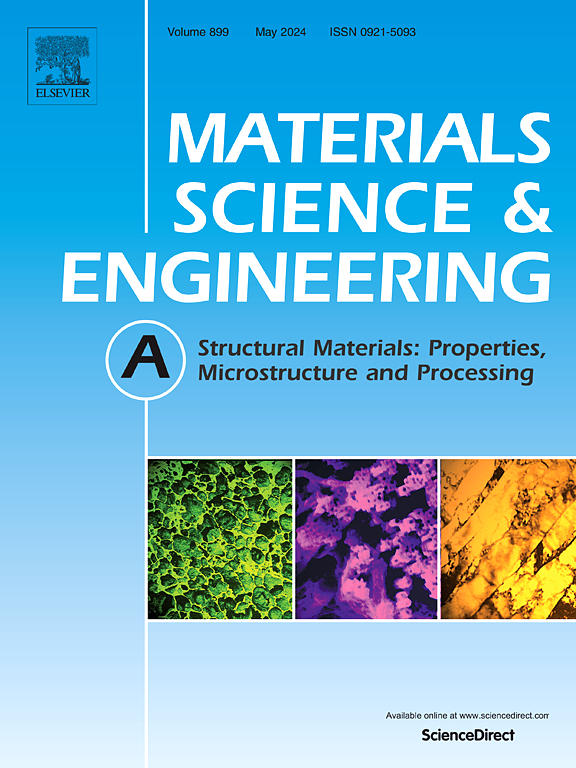织构和力学各向异性对热轧Fe-10Mn-4Al-1.5Si-0.3C中Mn钢超塑性行为的影响
IF 6.1
2区 材料科学
Q1 MATERIALS SCIENCE, MULTIDISCIPLINARY
引用次数: 0
摘要
本研究研究了热轧Fe-10Mn-4Al-1.5Si-0.3C钢的力学各向异性和超塑性行为,强调了织构演化与变形诱导铁素体转变之间的关系。实验结果表明,该合金在轧制方向上具有优异的超塑性,最大伸长率为1564%,显著超过热轧和冷轧中锰钢。横向(TD)和对角线(DD)样品的伸长率分别为620%和1060%。观察到的力学各向异性主要归因于织构演化和动态铁素体转变(γ→α)。温轧后的RD试样呈现出较强的FCC立方体织构,有利于超塑性变形过程中形变诱导的铁素体转变。这种转变细化了组织,增强了晶界滑动(GBS),导致了优异的伸长率。相比之下,TD样品保留了FCC相的主要黄铜轧制织构,这限制了铁素体的转变,降低了超塑性。800°C时的应变率敏感性(m)分析证实GBS是主要的变形机制,RD样品的m值最高,为0.72,这与其优越的伸长率有关。此外,动态晶粒共旋维持了变形诱导的α-铁素体和母晶γ-奥氏体之间的Kurdjumov-Sachs取向关系,有利于GBS和均匀变形。本研究强调了优化初始织构和相变行为在提高热轧中锰钢超塑性中的关键作用,为改进超塑性成形工艺提供了有价值的见解。本文章由计算机程序翻译,如有差异,请以英文原文为准。
Effects of texture and mechanical anisotropy on the superplastic behavior in warm-rolled Fe–10Mn–4Al–1.5Si–0.3C medium Mn steel
This study investigates the mechanical anisotropy and superplastic behavior of warm-rolled Fe–10Mn–4Al–1.5Si–0.3C steel, emphasizing the relationship between texture evolution and deformation-induced ferrite transformation. Experimental results reveal exceptional superplasticity in the rolling direction (RD), with a maximum elongation of 1564 %, significantly exceeding that of hot-rolled and cold-rolled medium Mn steels. The transverse direction (TD) and diagonal direction (DD) samples exhibited elongations of 620 % and 1060 %, respectively. The observed mechanical anisotropy is primarily attributed to texture evolution and dynamic ferrite transformation (γ→α). The RD sample exhibited a strong FCC Cube texture after warm rolling, which facilitated deformation-induced ferrite transformation during superplastic deformation. This transformation refined the microstructure and enhanced grain boundary sliding (GBS), leading to superior elongation. In contrast, the TD sample retained a dominant Brass rolling texture of FCC phase, which limited ferrite transformation and reduced superplasticity. Strain rate sensitivity (m) analysis at 800 °C confirmed GBS as the primary deformation mechanism, with the RD sample showing the highest m value of 0.72, correlating with its superior elongation. Further, dynamic grain co-rotation maintained the Kurdjumov–Sachs orientation relationship between deformation-induced α-ferrite and parent γ-austenite grains, facilitating GBS and uniform deformation. This study highlights the critical role of optimizing initial texture and phase transformation behavior in enhancing the superplasticity of warm-rolled medium Mn steels, providing valuable insights for improving superplastic forming processes.
求助全文
通过发布文献求助,成功后即可免费获取论文全文。
去求助
来源期刊

Materials Science and Engineering: A
工程技术-材料科学:综合
CiteScore
11.50
自引率
15.60%
发文量
1811
审稿时长
31 days
期刊介绍:
Materials Science and Engineering A provides an international medium for the publication of theoretical and experimental studies related to the load-bearing capacity of materials as influenced by their basic properties, processing history, microstructure and operating environment. Appropriate submissions to Materials Science and Engineering A should include scientific and/or engineering factors which affect the microstructure - strength relationships of materials and report the changes to mechanical behavior.
 求助内容:
求助内容: 应助结果提醒方式:
应助结果提醒方式:


